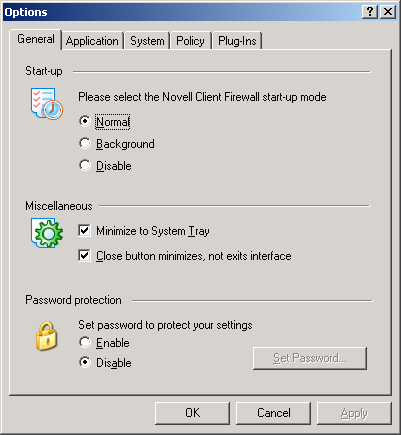Right-click the NCF system tray icon ![]() .
.
Click Options.
The settings window opens:
Figure 8
Options Dialog Box (General Tab)
The General tab contains Start-up, Miscellaneous, and Password Protection settings.
Start-up
Normal---This is the default startup mode, which loads NCF automatically at startup and displays its icon in the system tray.
Background---This is the invisible mode, without its system tray icon or any of its dialog boxes. This option is provided for two reasons: to save system resources and for a parent or Systems Administrator to block unwanted traffic or content in a way that's completely hidden from a user.
Miscellaneous
Minimize to System Tray---When selected, a button is not placed on the task bar for NCF's main window whenever it is minimized. To see NCF's main window, simply double-click NCF's system tray icon, or right-click it and then click Show Novell Client Firewall.
Close Button Minimizes, Not Exits Interface---When selected, this ensures that whenever you click the Close button, only NCF's dialog box will be closed, not the firewall. To shutdown NCF, right-click NCF's system tray icon and then click Exit and Shutdown NCF.
Password
Enable---Protects your firewall settings with a password. Click Set Password to create a password for your settings.
Disable---Leaves your firewall settings unprotected so that anyone can change them.
If you choose to have your NCF settings protected by password, only you can change its configuration.